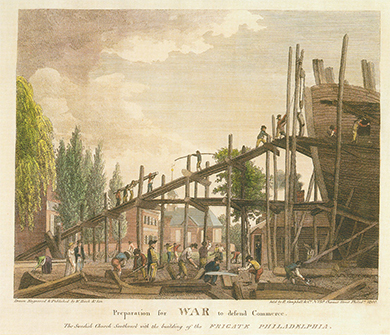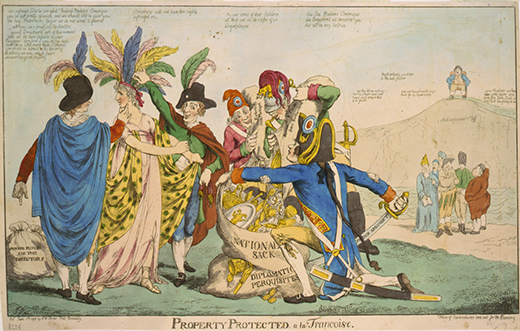| << Chapter < Page | Chapter >> Page > |

In 1797, Adams sought a diplomatic solution to the conflict with France and dispatched envoys to negotiate terms. The French foreign minister, Charles-Maurice de Talleyrand, sent emissaries who told the American envoys that the United States must repay all outstanding debts owed to France, lend France 32 million guilders (Dutch currency), and pay a £50,000 bribe before any negotiations could take place. News of the attempt to extract a bribe, known as the XYZ affair because the French emissaries were referred to as X, Y, and Z in letters that President Adams released to Congress, outraged the American public and turned public opinion decidedly against France ( [link] ). In the court of public opinion, Federalists appeared to have been correct in their interpretation of France, while the pro-French Democratic-Republicans had been misled.

Read the “transcript” of the above cartoon in the America in Caricature, 1765–1865 collection at Indiana University’s Lilly Library.
The complicated situation in Haiti, which remained a French colony in the late 1790s, also came to the attention of President Adams. The president, with the support of Congress, had created a U.S. Navy that now included scores of vessels. Most of the American ships cruised the Caribbean, giving the United States the edge over France in the region. In Haiti, the rebellion leader Toussaint, who had to contend with various domestic rivals seeking to displace him, looked to end an U.S. embargo on France and its colonies, put in place in 1798, so that his forces would receive help to deal with the civil unrest. In early 1799, in order to capitalize upon trade in the lucrative West Indies and undermine France’s hold on the island, Congress ended the ban on trade with Haiti—a move that acknowledged Toussaint’s leadership, to the horror of American slaveholders. Toussaint was able to secure an independent black republic in Haiti by 1804.
The surge of animosity against France during the Quasi-War led Congress to pass several measures that in time undermined Federalist power. These 1798 war measures, known as the Alien and Sedition Acts, aimed to increase national security against what most had come to regard as the French menace. The Alien Act and the Alien Enemies Act took particular aim at French immigrants fleeing the West Indies by giving the president the power to deport new arrivals who appeared to be a threat to national security. The act expired in 1800 with no immigrants having been deported. The Sedition Act imposed harsh penalties—up to five years’ imprisonment and a massive fine of $5,000 in 1790 dollars—on those convicted of speaking or writing “in a scandalous or malicious” manner against the government of the United States. Twenty-five men, all Democratic-Republicans, were indicted under the act, and ten were convicted. One of these was Congressman Matthew Lyon ( [link] ), representative from Vermont, who had launched his own newspaper, The Scourge Of Aristocracy and Repository of Important Political Truth .

Notification Switch
Would you like to follow the 'U.s. history' conversation and receive update notifications?